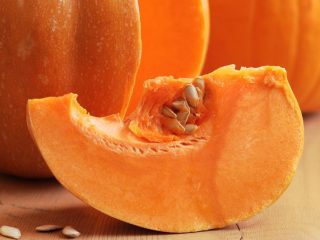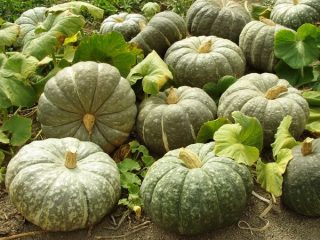Content
Muscat de Provence pumpkin is a mid-season French variety bred by Clause Tezier. The variety has high yield and relative ease of care. Pumpkin can be grown in warm and temperate climates; its fruits have excellent taste, good keeping quality and transportability.
Description of the Muscat Provençal pumpkin variety
According to the description of the Muscat Provence pumpkin variety, the plant is a grass with thick, rough vines spreading along the ground. The number of lashes reaches 4-7. Their length can reach several meters.
There are tendrils on the lashes, with which the pumpkin clings to obstacles and climbs up them. Also on the stems are large five-lobed leaves, with a diameter of 5 to 8 cm. Large flowers (up to 10 cm in diameter) are yellow-white. They are bell-shaped and have 5 petals. Flowering time occurs at the end of May.
Flowering lasts several days.Pollination is carried out with the help of insects, mainly bees. In their absence, pollination is carried out artificially. Pumpkin fruits are called gourds. As a rule, 1-2 pumpkins are tied on one stem.
Description of fruits
The fruits are about 40 cm in diameter and weigh from 7 to 10 kg. They are orange-brown in color and have a rounded-flattened shape. The ribbing of the fruit is pronounced. At the stage of technical ripeness, the color of the fruit is grayish-green. The crust is strong and smooth.
The pulp of the Muscat de Provence fruit has a bright orange color, it is dense and very sweet. Pumpkin pulp contains more than 15% sugar and more than 20% starch. Pumpkin contains vitamins C, E, B1 and B2, phosphoric and silicic acid, large amounts of iron, calcium, magnesium and other trace elements.
The pulp is mainly used for making juices and purees, but it can also be consumed fresh. Muscat of Provence is a dietary product. Its pulp is recommended for use by people suffering from diseases of the cardiovascular, digestive and excretory systems.
Separately, it should be said about the beneficial properties of Muscat de Provence seed oil. The pumpkin oil they contain is used to prevent diseases of the nervous and endocrine systems.
The shelf life of ripe pumpkins is about six months.
Characteristics of Muscat de Provence pumpkin
The Muscat de Provence pumpkin variety is not frost-resistant and requires about 4 months from germination to full ripening, so in the northern regions it may simply not have time to ripen.
The plant has average drought resistance; it requires regular watering every 7-10 days.
The yield ranges from 3 to 5 fruits per plant, which, depending on the degree of planting, corresponds to 20-30 kg per 1 sq. m.
Resistance to pests and diseases
Disease resistance of this variety is average. Like all pumpkins, it can be susceptible to attacks by fungal diseases (bacteriosis, powdery mildew, etc.), as well as pest invasions, in particular spider mites.
Fungal diseases can be stopped by spraying the foliage with a 1% solution of copper sulfate. In the case of powdery mildew, an additional 70% solution of colloidal sulfur is used.
When traces of spider mite activity appear on the stems (the green part of the plant is entwined with a sticky web), a tincture of onion and garlic peels is used. Spraying is done daily for 10 days.
Advantages and disadvantages
According to reviews, Provençal nutmeg pumpkin has the following advantages:
- unpretentiousness in cultivation;
- large fruits with excellent taste;
- high productivity;
- good preservation of fruits.
The disadvantages include:
- impossibility of cultivation in the northern regions;
- vulnerability to fungal diseases in humid climates.
Technology for growing pumpkin Muscat de Provence
You can grow Muscat de Provence pumpkin using both seedlings and non-seedlings. Naturally, in colder climates the first planting method is used, in warmer climates the second is used. Theoretically, it is possible to speed up the ripening time of pumpkins if you use the seedling method of growing and growing pumpkins in a greenhouse, but in practice this is rarely done, since pumpkins require quite large areas, and growing them in greenhouses is not justified.
Since Muscat Provence pumpkin prefers soils with a large amount of humic compounds and soluble mineral salts, it should be grown on medium-density loams with neutral acidity.
It is advisable to fertilize the soil with humus or rotted manure six months before planting pumpkins.
Precursors to pumpkin can be cruciferous vegetables, legumes, onions, beets or radishes. It is recommended to plant green manure from legumes or cereals on the site before planting.
Planting in open ground
For sowing pumpkin without seedlings, only large, high-quality seeds that have been tested are used. In this case, dried seeds or those with damaged shells are immediately selected.
The seeds are pre-treated to speed up the emergence of seedlings. To do this, they are heated for 2-3 hours at a temperature of + 50-60 ° C, and then germinated wrapped in gauze moistened with water for several days. After which they are sown 2-3 pieces in one hole in the garden.
In this case, a square-cluster method of cultivation is used and a sowing pattern from 0.7x0.7 m to 1.5x1.5 m. The seeds are buried 5-10 cm. The usual time for planting seeds is the end of April or mid-May, when the soil is at a depth of 10-12 cm it will heat up to a temperature of at least + 12-14 °C.
Under favorable circumstances, Muscat Provence pumpkin shoots will appear within 1-1.5 weeks. Of several sprouted plants in one hole, a week after germination, one, the strongest, is left.
Seedling cultivation
If an earlier harvest is needed, pumpkin can be planted through seedlings. The procedure for planting a plant through seedlings is quite simple.
Changes are planted in early or mid-April in pots.The soil composition is standard for seedlings of any other garden crop. This can be a two- or three-component mixture (peat and sand; earth, humus and sand; earth, peat and sand, etc. in the required proportions), or it can just be ordinary soil brought from the garden in which the cultivation will take place .
After about a week, the first shoots appear. In two weeks they will take root, become stronger and be ready for planting in open ground. Next, they are treated in the same way as seeds when grown in open ground (square-cluster planting with a step of 0.7 to 1.5 m).
Weeding
Caring for the Muscat pumpkin consists of regular destruction weed, watering, fertilizing and other ongoing work on the site. The large area of the site, free in the first months of cultivation, allows a large number of weeds to germinate. In addition, as the plant grows, the complexity of these works increases, since the overgrown pumpkin does not allow it to move freely around the site.
Therefore, the period when the crop begins to grow, until the pumpkin vines reach a length of about 1 m, should be primarily devoted to weed control. They should be weeded regularly, every 3-4 days, while trying not to touch the young shoots.
Watering
Watering is the most critical in caring for the plant, since on fertile soil the pumpkin does not need any other care besides it.The recommended frequency of watering is once a week. The water consumption rate is 20 liters per 1 sq. m. During fruit ripening, this norm is reduced to 10 liters per 1 sq. m. m to avoid cracks in the fruit.
Feeding
If the soil is sufficiently fertile, the plant does not need fertilizing. In case of poor soils, it is necessary to feed it 2 times a month with nitrogen and potassium fertilizers. It is recommended to combine organic and complex mineral fertilizers.
Support for stems
Separately, it should be said about the additional supports to which the pumpkin stems will be attached. Since the plant can form from 4 to 7 vines, and their length reaches 8 m, the area of the site may not be enough to accommodate such a large volume of green mass. In order for everything to be placed quite compactly, special supports are used in the form of coarse mesh stretched between the posts, to which the tendrils of the stems will cling.
Their height should not be too large, since the mass of pumpkin fruits is very large. Typically, meshes with a height of about 0.5 m are used.
Conclusion
Muscat de Provence pumpkin is a mid-season variety with large fruits and excellent taste. The variety is quite unpretentious and requires minimal care when growing. The fruits can be stored for six months without loss of taste.
Reviews of Muscat de Provence pumpkin













